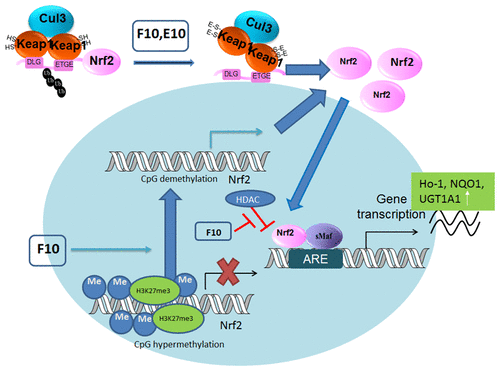当前位置:
X-MOL 学术
›
Chem. Res. Toxicol.
›
论文详情
Our official English website, www.x-mol.net, welcomes your
feedback! (Note: you will need to create a separate account there.)
Curcumin Derivative Epigenetically Reactivates Nrf2 Antioxidative Stress Signaling in Mouse Prostate Cancer TRAMP C1 Cells
Chemical Research in Toxicology ( IF 3.7 ) Pub Date : 2018-01-08 00:00:00 , DOI: 10.1021/acs.chemrestox.7b00248 Wenji Li,Zheng-Yuan Su,Yue Guo,Chengyue Zhang,Renyi Wu,Linbo Gao,Xi Zheng,Zhi-Yun Du,Kun Zhang,Ah-Ng Kong
Chemical Research in Toxicology ( IF 3.7 ) Pub Date : 2018-01-08 00:00:00 , DOI: 10.1021/acs.chemrestox.7b00248 Wenji Li,Zheng-Yuan Su,Yue Guo,Chengyue Zhang,Renyi Wu,Linbo Gao,Xi Zheng,Zhi-Yun Du,Kun Zhang,Ah-Ng Kong

|
The carcinogenesis of prostate cancer (PCa) in TRAMP model is highly correlated with hypermethylation in the promoter region of Nrf2 and the accompanying reduced transcription of Nrf2 and its regulated detoxifying genes. We aimed to investigate the effects of (3E,5E)-3,5-bis-(3,4,5-trimethoxybenzylidene)-tetrahydro-thiopyran-4-one (F10) and (3E,5E)-3,5-bis-(3,4,5-trimethoxy-benzylidene)-tetrahydropyran-4-one (E10), two synthetic curcumin derivatives, on restoring Nrf2 activity in TRAMP C1 cells. HepG2-C8 cells transfected with an antioxidant-response element (ARE)-luciferase vector were treated with F10, E10, curcumin, and sulforaphane (SFN) to compare their effects on Nrf2-ARE pathways. We performed real-time quantitative PCR and Western blotting to investigate the effects of F10 and E10 on Nrf2, correlated phase II detoxification genes. We also measured expression and activity of DNMTand HDAC enzymes. Enrichment of H3K27me3 on the promoter region of Nrf2 was explored with a chromatin immunoprecipitation (ChIP) assay. Methylation of the CpG region in Nrf2 promoter was doubly examined by bisulfite genomic sequencing (BGS) and methylation DNA immunoprecipitation (MeDIP). Compared with curcumin and SFN, F10 is more potent in activating Nrf2-ARE pathways. Both F10 and E10 enhanced level of Nrf2 and the correlated phase II detoxifying genes. BGS and MeDIP assays indicated that F10 but not E10 hypomethylated the Nrf2 promoter. F10 also downregulated the protein level of DNMT1, DNMT3a, DNMT3b, HDAC1, HDAC4, and HDAC7 and the activity of DNMTs and HDACs. F10 but not E10 effectively reduced the accumulation of H3k27me3 on the promoter of Nrf2. F10 and E10 can activate the Nrf2-ARE pathway and increase the level of Nrf2 and correlated phase II detoxification genes. The reactivation effect on Nrf2 by F10 in TRAMP C1 may come from demethylation, decrease of HDACs, and inhibition of H3k27me3 accumulation.
中文翻译:

姜黄素衍生物表观遗传激活小鼠前列腺癌TRAMP C1细胞中的Nrf2抗氧化应激信号。
在TRAMP模型中,前列腺癌(PCa)的致癌作用与Nrf2启动子区域的高甲基化以及Nrf2及其调控的解毒基因的转录降低相关。我们旨在研究(3E,5E)-3,5-双-(3,4,5-三甲氧基亚苄基)-四氢-噻喃-4-酮(F10)和(3E,5E)-3,5-双(3,4,5-三甲氧基-亚苄基)-四氢吡喃-4-酮(E10),两种合成的姜黄素衍生物,可恢复TRAMP C1细胞中的Nrf2活性。用F10,E10,姜黄素和萝卜硫素(SFN)处理转染了抗氧化剂-反应元件(ARE)-荧光素酶载体的HepG2-C8细胞,以比较它们对Nrf2-ARE途径的影响。我们进行了实时定量PCR和Western印迹,以研究F10和E10对Nrf2(相关的II期排毒相关基因)的影响。我们还测量了DNMT和HDAC酶的表达和活性。H3K27me3在Nrf2的启动子区域的富集用染色质免疫沉淀(ChIP)分析进行了探讨。通过亚硫酸氢盐基因组测序(BGS)和甲基化DNA免疫沉淀(MeDIP)双重检查了Nrf2启动子中CpG区的甲基化。与姜黄素和SFN相比,F10在激活Nrf2-ARE途径上更有效。F10和E10均可增强Nrf2和相关的II期解毒基因的水平。BGS和MeDIP分析表明F10而不是E10甲基化了Nrf2启动子。F10还下调了DNMT1,DNMT3a,DNMT3b,HDAC1,HDAC4和HDAC7的蛋白质水平以及DNMT和HDAC的活性。F10而不是E10有效地减少了H3k27me3在Nrf2启动子上的积累。F10和E10可以激活Nrf2-ARE途径并增加Nrf2和相关的II期排毒基因的水平。FAMP在TRAMP C1中对Nrf2的再激活作用可能来自去甲基化,HDAC的减少和H3k27me3积累的抑制。
更新日期:2018-01-08
中文翻译:

姜黄素衍生物表观遗传激活小鼠前列腺癌TRAMP C1细胞中的Nrf2抗氧化应激信号。
在TRAMP模型中,前列腺癌(PCa)的致癌作用与Nrf2启动子区域的高甲基化以及Nrf2及其调控的解毒基因的转录降低相关。我们旨在研究(3E,5E)-3,5-双-(3,4,5-三甲氧基亚苄基)-四氢-噻喃-4-酮(F10)和(3E,5E)-3,5-双(3,4,5-三甲氧基-亚苄基)-四氢吡喃-4-酮(E10),两种合成的姜黄素衍生物,可恢复TRAMP C1细胞中的Nrf2活性。用F10,E10,姜黄素和萝卜硫素(SFN)处理转染了抗氧化剂-反应元件(ARE)-荧光素酶载体的HepG2-C8细胞,以比较它们对Nrf2-ARE途径的影响。我们进行了实时定量PCR和Western印迹,以研究F10和E10对Nrf2(相关的II期排毒相关基因)的影响。我们还测量了DNMT和HDAC酶的表达和活性。H3K27me3在Nrf2的启动子区域的富集用染色质免疫沉淀(ChIP)分析进行了探讨。通过亚硫酸氢盐基因组测序(BGS)和甲基化DNA免疫沉淀(MeDIP)双重检查了Nrf2启动子中CpG区的甲基化。与姜黄素和SFN相比,F10在激活Nrf2-ARE途径上更有效。F10和E10均可增强Nrf2和相关的II期解毒基因的水平。BGS和MeDIP分析表明F10而不是E10甲基化了Nrf2启动子。F10还下调了DNMT1,DNMT3a,DNMT3b,HDAC1,HDAC4和HDAC7的蛋白质水平以及DNMT和HDAC的活性。F10而不是E10有效地减少了H3k27me3在Nrf2启动子上的积累。F10和E10可以激活Nrf2-ARE途径并增加Nrf2和相关的II期排毒基因的水平。FAMP在TRAMP C1中对Nrf2的再激活作用可能来自去甲基化,HDAC的减少和H3k27me3积累的抑制。











































 京公网安备 11010802027423号
京公网安备 11010802027423号